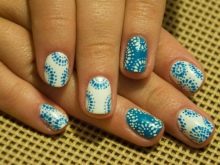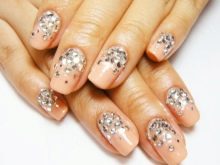It is not so easy to grow nails of the right length and protect them from damage and breakage. Often, because of one injured due to negligence of the nail, you have to adjust their length on all fingers. So, a few weeks spent on growing, go down the drain. Therefore, many prefer to build nail plates on their short nails. The article will discuss the features of the procedure for nail extension with gel.
To do or not?
It is immediately worth noting that there are no restrictions on the length of a natural nail for carrying out the extension procedure. Gel or acrylic can be extended even to a very short base.
There is a huge plus in building: no need to wait until your own nails grow to the desired length. In addition, artificial ones are much stronger. And in case of breaking one or a couple of artificial nails, you can easily and quickly restore the plates on your fingers by contacting the master.

What to choose?
At the moment, to implement the extension of artificial nail cover, the masters use two materials: acrylic and gel. In many ways they are similar, but there are some differences.
Pros and cons of acrylic.
- A significant plus is the strength of the extended plates. To remove acrylic plates, there is no need to carry out a relatively quick sawing procedure. Acrylic nails are removed using special solvent compositions. The coating of this material is smooth and neat, well imitating a natural nail.
- The disadvantage of this material is a rather noticeable smell, which is present for some time after building.That is why more and more often the choice of masters and those who want to build their nails themselves falls on the gel composition.



Features of gel extension
The advantage of using this material is the shorter time required for the entire procedure. This substance hardens very quickly under the influence of special drying lamps, which are in every cabin. The gel is odorless and hypoallergenic. In the case when the extension is carried out on short nails, the master uses nail tips as the basis for the gel. The built-in gel plates look much more natural than acrylic ones.
With regular correction, gel plates will please you for at least 4 months.
The weak side is that gel plates break more often upon impact. Another drawback mentioned above is that the gel plate removal procedure is rather slow. The hardened gel cannot be dissolved and quickly removed, it must be carefully grinded and filed off step by step with special manicure tools.
In addition, gel nails do not tolerate sudden changes in temperature. For example, when the cold weather comes out of a warm room, the gel coating becomes much more fragile and inelastic. Therefore, in such situations, it is worth saving your artificial nails.



Build-up procedure
The main condition for the extension is the absence of wounds, injuries or cracks on the nails and the prong nail zone of the fingers. Therefore, the master should have a good look at your hands before you get to work.
The first step is preparation.
- Nail plates are degreased. If necessary, the master carries out the correction of the form.
- Cuticles are cut using an unedged method to avoid injuries to nails or skin.
- For better fixation of the patch material, the surface is sanded with a soft file or a machine.
- Then a special composition - primer is applied to the nails. It dries the surface a little, removing excess moisture.
- Before starting the procedure, the master will hold your fingers under the UV lamp in order to disinfect the skin.

After the preparatory phase, the gel building process itself begins.
For short nails, it is preferable to use tips. They are superimposed on the nail plate and form the basis for the gel coating layer, which will imitate a long nail.
The process is as follows.
- The master glues tips on the prepared nail plates for the procedure.
- Gel is layered on the tips. Each layer is dried under the lamp. The gel hardens very quickly, so the time between application of layers is very short. Usually enough two applications of the composition for building.
- After the final layer is fully fixed, the master will process the new artificial nails and give them the desired shape. This is done with a nail file.



Care
Correction of the form is recommended twice a month. Artificial gel nails are allowed to be decorated in all ways that are possible for natural nail plates. You can do it yourself at home. The only important rule is that the nail polish remover should not contain acetone. This component is too aggressive for gel coating.
After removing the gel, carry out procedures to strengthen your own nail plates. It is useful to make nourishing baths with iodized sea salt. It is also recommended that you periodically arrange fingers with masks of essential oils or natural juices.



Tips from professional masters on manicure and nail extensions.
- During the gel application procedure, it is important to try not to move your fingers and hands. The composition that has not yet solidified can be easily damaged, and the master will have to remove the defective layer and begin processing the nail from the very beginning.
- Try to monitor the condition of the nail plates and cuticles.The presence of burrs, uneven, nibbled edges on nails, damaged or broken nail edges is highly undesirable.

Problematic nails significantly complicate the task of the master. We will have to carry out a number of additional preparatory procedures. In many cases, it may be necessary to postpone the build-up for the time necessary to eliminate the defects.
Professionals recommend abandoning women’s building on critical days. This also applies to periods of illness, mild colds, taking potent drugs.
- Two days before the procedure, it is advisable not to use creams, gels, lotions and other means applied to the skin of the hands and fingers.
- In no case do not try to remove the extended artificial plates from the nails yourself. It requires certain knowledge and skill. If necessary, remove gel nails, contact a professional.
- If you have not worn long nails before, it is recommended for the first experiment to choose not too long. You will need time to get used to other sensations. Best of all, if the extended part of the plate will not be more than two-thirds of the length of your nail.
- If you plan to use heavy elements (for example, rhinestones) for further decoration of gel plates, do not overload their tip. Try to make the composition so that the weight falls on half of the nail closer to the base and in the middle.



Acrylic building
The extension of acrylic on short nails occurs in almost the same way. After preparing the nail plates, the master fixes the tips for the base on them. Next, layer-by-layer application of artificial material to simulate a nail of the desired length.
Acrylic can also be subjected to any decoration.
About how the process of nail extension with acrylic occurs, see the video below.










